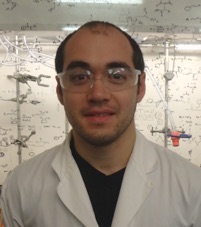Org. Synth. 2019, 96, 351-360
DOI: 10.15227/orgsyn.096.0351
Stereoselective Synthesis of (R)-((R)-1-Phenyl-2,2,2-trichloroethyl)2-(2-bromophenyl)aziridine-1-carboxylate
Submitted by Hélène Lebel* and Henri Piras
Checked by Tony Z. Scott, Aniket Dehadrai, and Mohammad Movassaghi
1. Procedure (Note 1)
(R)-((R)-1-Phenyl-2,2,2-trichloroethyl)2-(2-bromophenyl)aziridine-1-carboxylate (1). A 100 mL single-necked round-bottomed flask equipped with a 2.5 cm egg-shaped Teflon-coated magnetic stirrer is charged with
(R)-1-phenyl-2,2,2-trichloroethyl-N-mesyloxycarbamate (2.96 g, 8.20 mmol, 1.20 equiv). The white solid is suspended in
α,α,α-trifluorotoluene (13.6 mL) (
Note 2).
Rh2[(S)-4-Br-nttl]4 (181 mg, 0.10 mmol, 1.5 mol %) and
2-bromostyrene (0.88 mL, 6.8 mmol, 1 equiv) (
Note 3) are successively added to the flask (
Note 4). The gray mixture is stirred for 5 min at 23 ºC. An aqueous saturated
potassium carbonate solution (1.26 mL, 10.2 mmol, 1.50 equiv) (
Note 5) is added and the resulting green mixture is vigorously stirred (1100 rpm) at 23 ºC for 12 h (
Note 6).
Figure 1. Reaction appearance before (left) and after (right) addition of an aqueous saturated potassium carbonate solution (photos provided by submitters)
The dark brown reaction mixture is quenched by addition of 4-5 drops of
pyridine, stirred 30 seconds and filtered on a pad of celite (5 g) (Notes
7 and
8) by suction using a fritted glass funnel. The reaction flask and the Celite cake are washed with
diethyl ether (3 x 40 mL). The brownish filtrate is concentrated by rotary evaporation (450 to 20 mmHg, 40 °C) to afford a brownish oil. The crude product is filtered through a pad of silica gel (12 g) (Notes
9 and
10), pretreated with a mixture of 5% of
triethylamine in hexanes (Figure 2). The crude product is eluted with a mixture of
diethyl ether in hexanes (1:9) (Notes
11,
12 and
13). The fractions (50 mL) are collected, transferred one at a time in a 200 mL round-bottomed flask and concentrated by rotary evaporation (300 to 160 mmHg, 40 °C). During concentration, crystallization of the major diastereomer spontaneously occurs (
Note 14). When approx. 6-8 mL remain in the flask, the evaporation is stopped and hexanes (5 mL) is added. The crystals are filtered through a 4 cm diameter fritted glass funnel, washed with hexanes (2 x 8 mL) and collected (Figure 2). The yellow crystals are dried under high vacuum (0.5 mmHg) for 16 h, affording 1.43 g (47% yield, 99:1 dr) of the desired product (
1) (Notes
15 and
Note 16).
Figure 2. Filtration of the crude product on silica gel (left) and crystals of the major diastereomer (right, photos provided by submitters)
2. Notes
1. Prior to performing each reaction, a thorough hazard analysis and risk assessment should be carried out with regard to each chemical substance and experimental operation on the scale planned and in the context of the laboratory where the procedures will be carried out. Guidelines for carrying out risk assessments and for analyzing the hazards associated with chemicals can be found in references such as Chapter 4 of "Prudent Practices in the Laboratory" (The National Academies Press, Washington, D.C., 2011; the full text can be accessed free of charge at
https://www.nap.edu/catalog/12654/prudent-practices-in-the-laboratory-handling-and-management-of-chemical. See also "Identifying and Evaluating Hazards in Research Laboratories" (American Chemical Society, 2015) which is available via the associated website "Hazard Assessment in Research Laboratories"
https://www.acs.org/content/acs/en/about/governance/committees/chemicalsafety/hazard-assessment.html. In the case of this procedure, the risk assessment should include (but not necessarily be limited to) an evaluation of the potential hazards associated with
(R)-1-phenyl-2,2,2-trichloroethyl-N-mesyloxycarbamate,
α,α,α-trifluorotol-uene,
Rh2[(S)-4-Br-nttl]4,
2-bromostyrene,
potassium carbonate,
pyridine, Celite,
diethyl ether, silica gel,
triethylamine, and hexanes.
2.
α,α,α-Trifluorotoluene (≥99%) was purchased from Sigma-Aldrich Fine Chemicals Company Inc. and used as received.
3. The catalyst (
Rh2[(S)-4-Br-nttl]4) was produced using the procedure described in
Org. Synth. 2017,
94, 136-152.
2-Bromostyrene (97%) was purchased from Sigma-Aldrich Fine Chemicals Company Inc. and used as received.
4. The initially brownish heterogeneous mixture, after the addition of the rhodium catalyst, turns grey upon the addition of
2-bromostyrene.
5. The submitters purchased
potassium carbonate from Caledon Company and used it as received. The checkers used
potassium carbonate purchased from Sigma-Aldrich Fine Chemicals Company Inc. and used it as received.
6. The reaction is monitored by TLC analysis on silica gel using a mixture of
diethyl ether in hexanes (1:9), visualized with UV light and revealed with phosphomolybdic acid (R
f styrene 0.75; R
f product (
1)
0.37).
7. The submitters purchased Celite 545 filter agent from Sigma-Aldrich Fine Chemicals Company Inc. The checkers purchased Celite 545 filter agent from Alfa Aesar.
8. The pad is a cylinder of 4 cm diameter and 2 cm height.
9. Silica gel F60 type, 40-63 μm (230-400 mesh) was purchased from American International Chemical.
10. The pad is a cylinder of 2.5 cm diameter and 6 cm height.
11. Approx. 200 mL of eluent is needed.
12. The filtration is followed by TLC analysis on silica gel using a mixture of
diethyl ether in hexanes (1:9), visualized with UV light and revealed with phosphomolybdic acid (R
f aziridine (
1) = 0.37). The desired protected aziridine is typically obtained in fractions 1 to 9.
13. The fractions are still purple/reddish after filtration due to the residual catalyst that co-elutes with the aziridine.
14. The submitters note that spontaneous crystallization systematically occurs in all batches superior or equal to 10 mmol scale. If the crystallization does not occur, the crude product is purified by flash column chromatography, using a mixture of
diethyl ether in hexanes (5:95). The crystallization occurred on the full scale run by the checkers. However, on the checkers' half scale run, the spontaneous crystallization did not occur. The product isolated after chromatography in this half scale run was between 90:10 and 95:5 d.r. and 50% yield. Thus the crystallization further enriches the isolated d.r.
15. Analytical data for
(R)-((R)-1-phenyl-2,2,2-trichloroethyl)2-(2-bromophenyl)aziridine-1-carboxylate (
1). R
f 0.37 (
diethyl ether in hexanes (1:9));
1H NMR
pdf (600 MHz, CDCl
3) δ: 2.30 (d,
J = 3.7 Hz, 1H), 2.86 (d,
J = 6.5 Hz, 1H), 3.88 (dd,
J = 6.5, 3.7 Hz, 1H), 6.34 (s, 1H), 7.20 (td,
J = 7.7, 1.7 Hz, 1H), 7.33 (td,
J = 7.5, 1.2 Hz, 1H), 7.39-7.46 (m, 4H), 7.57 (dd,
J = 8.0, 1.2 Hz, 1H), 7.67-7.63 (m, 2H);
13C NMR
pdf (150 MHz, CDCl
3) δ: 35.4, 40.2, 84.5, 99.3, 123.4, 127.8, 127.9, 128.2, 129.6, 129.8, 130.0, 132.6, 132.8, 136.2, 161.1; IR (film) 3063, 2952, 1738, 1321, 1268, 1165, 756, 698 cm
-1; mp 94-96 °C (submitters: mp 110-112 °C); [α]
D25 -95 (c 1.00, CHCl
3); Diastereomeric ratio is determined to be 99:1 by analytical supercritical fluid chromatography (SFC), using the following conditions: Chiracel-AD-3 chiralpak column (4.6 mm x 150 mm) 4 to 40% isopropanol in CO
2 over 9 min (start at 4% isopropanol in CO
2 for 4 min), 40 °C, 2000 psi; retention time: t
major 6.28 min and t
minor 6.88 min; (Note: Given that
1 is not stable in methanol, the sample for SFC analysis should be prepared in acetonitrile). HRMS (DART)
m/z: [M+H
+] calc. for C
17H
1479Br
35Cl
3NO
2 447.92680; found 447.92732. Anal. calc. for C
17H
13BrCl
3NO
2: N, 3.12, C, 45.42, H, 2.91; found: N, 3.00, C, 45.37, H, 2.91.
16. A second reaction on half-scale provided 761 mg (50%) of the product.
Working with Hazardous Chemicals
The procedures in
Organic Syntheses are intended for use only by persons with proper training in experimental organic chemistry. All hazardous materials should be handled using the standard procedures for work with chemicals described in references such as "Prudent Practices in the Laboratory" (The National Academies Press, Washington, D.C., 2011; the full text can be accessed free of charge at
http://www.nap.edu/catalog.php?record_id=12654). All chemical waste should be disposed of in accordance with local regulations. For general guidelines for the management of chemical waste, see Chapter 8 of Prudent Practices.
In some articles in Organic Syntheses, chemical-specific hazards are highlighted in red "Caution Notes" within a procedure. It is important to recognize that the absence of a caution note does not imply that no significant hazards are associated with the chemicals involved in that procedure. Prior to performing a reaction, a thorough risk assessment should be carried out that includes a review of the potential hazards associated with each chemical and experimental operation on the scale that is planned for the procedure. Guidelines for carrying out a risk assessment and for analyzing the hazards associated with chemicals can be found in Chapter 4 of Prudent Practices.
The procedures described in Organic Syntheses are provided as published and are conducted at one's own risk. Organic Syntheses, Inc., its Editors, and its Board of Directors do not warrant or guarantee the safety of individuals using these procedures and hereby disclaim any liability for any injuries or damages claimed to have resulted from or related in any way to the procedures herein.
Discussion
Stereoselective aminations of alkenes and alkanes are achieved using namely metal nitrene species.
2,3,4,5,6 Among the available metal nitrene precursors, (
R)-2,2,2-trichloro-1-phenylethyl (methylsulfonyl)oxycarb-amate has emerged as a highly practical reagent that undergoes stereoselective aziridination and C-H amination reactions with very good level of chiral induction in the presence of
Rh2{(S)-4-Br-nttl}4.
7,8 The easy to prepare and highly stable
N-mesyloxycarbamate reagent affords low molecular weight biodegradable (after protonation) methanesulfonate as a byproduct and produce easily cleavable carbamate-protected aziridines or amines.
At the outset, the aziridination of styrene derivatives has been reported with the corresponding
N-tosyloxycarbamate reagent.
7 Similar yields and stereoselectivities are obtained with (
R)-2,2,2-trichloro-1-phenylethyl (methylsulfonyl)oxycarbamate in the presence of chiral rhodium catalyst,
Rh2{(S)-4-Br-nttl}4. The scope of the aziridination reaction includes styrene derivatives containing diversely functionalized aromatic ring as well as β-methylstyrene (eq 1).
The aziridination reaction is run at room temperature using 1.2 equiv of the N-mesyloxycarbamate reagent and an aqueous saturated solution of potassium carbonate. Pyridine is added to quench Rh2{(S)-4-Br-nttl}4 (through bonding at the apical positions) and afford a red complex. The filtration on celite removes the methanesulfonate by-product. A fraction of the pyridine rhodium complex is removed by filtration on silica gel that must be treated with 5% trimethylamine in hexanes, to avoid decomposition of the aziridine carbamate product. Upon evaporation of the filtrate, the major diastereomer of the aziridine product crystallizes (56% yield, 99:1 dr). Further treatment of the filtrate, namely with poly(4-vinylpyridine), 2% cross-linked (to remove the rhodium catalyst via the formation of an insoluble complex with Rh2{(S)-4-Br-nttl}4), furnishes an additional amount (13%) of the desired product as a mixture of diastereomers (83:17).
The cleavage of the (
R)-2,2,2-trichloro-1-phenylethyl carbamate undergoes under basic reaction conditions, avoiding the concomitant opening of the aziridine moiety, that is typically observed for cleavage of sulfonyl-protected aziridines (under acidic reaction conditions).
9 Both the free aziridine and (
R)-2,2,2-trichlorophenylethanol are recovered in high yields and with no loss of enantiopurity (eq 2).
Appendix
Chemical Abstracts Nomenclature (Registry Number)
(R)-1-Phenyl-2,2,2-trichloroethyl-N-mesyloxycarbamate: Methanesulfonic acid, [[(1R)-2,2,2-trichloro-1-phenylethoxy]carbonyl]azanyl ester; (1391853-96-5)
Rh2{(S)-4-Br-nttl}4: Rhodium, tetrakis[μ-[(αS)-6-bromo-a-(1,1-dimethylethyl)-1,3-dioxo-1H-benz[de]isoquinoline-2(3H)-acetato-κO2:κO2']]di-, (Rh-Rh); (802910-46-9)
2-Bromostyrene: Benzene, 1-bromo-2-ethenyl- ; (2039-88-5)
Pyridine: Pyridine; (110-86-1)
(R)-((R)-1-Phenyl-2,2,2-trichloroethyl)2-(2-bromophenyl)aziridine-1-carboxylate: 1-Aziridinecarboxylic acid, 2-(2-bromophenyl)-, (1R)-2,2,2-trichloro-1-phenylethyl ester, (2R)-; (1) (1335126-55-0)

|
Prof. Hélène Lebel obtained a BSc degree from Université Laval (1993) and a Ph.D. from Université de Montréal (1998). She then joined the group of Eric N. Jacobsen at Harvard University as a NSERC Postdoctoral Fellow. She began her academic career at the Université de Montréal in 1999, under a NSERC University Faculty Award. She was promoted to the rank of Full Professor in 2010. Her research interests focus on the development of new synthetic methodologies in organic chemistry based on transition metal-catalyzed processes. |

|
Henri Piras was born in Paris and raised in l'île de la Réunion, in France. He obtained in 2011, an Engineer degree in synthetic and industrial organic chemistry from the École National Supérieure de Chimie de Clermont-Ferrand, and a MSc degree from Université Blaise-Pascal under the supervision of Prof. Yves Troin. Since January 2012, he has been a Ph.D. student with Prof. Hélène Lebel at Université de Montréal, working on the stereoselective synthesis of chiral sulfilimines and sulfoximines. |

|
Tony Scott is originally from New York City. He received his B.S. degree from Yale University in 2017, where he conducted research in the laboratory of Professor Seth B. Herzon. In 2017 he began his graduate studies in the laboratory of Professor Mohammad Movassaghi at the Massachusetts Institute of Technology. His research focuses on complex alkaloid total synthesis. |

|
Aniket Dehadrai was born in Chicago, Illinois. He is currently completing his SB in Chemistry and Biology at the Massachusetts Institute of Technology. In 2018, he undertook undergraduate research in the laboratory of Professor Mohammad Movassaghi at MIT, where he gained an appreciation for natural product total synthesis. |
Copyright © 1921-, Organic Syntheses, Inc. All Rights Reserved